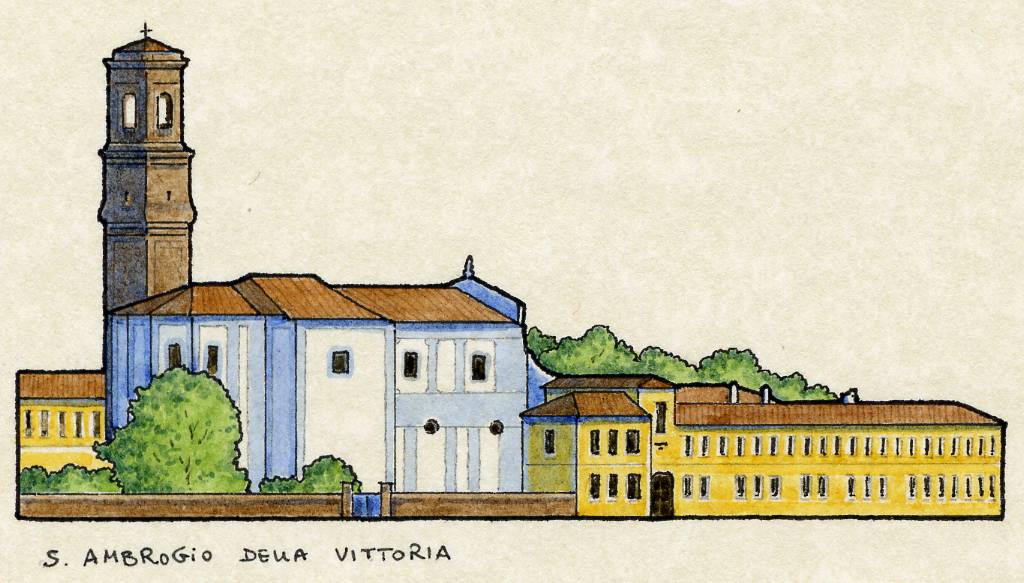Description

Here we can
admire the walls with the two really high chapel. They both have near
pilaster
with elaborate arches. In the center of
the wall there are two balconies, and in one of them is contained the
organ.
Balconies and balustrades of the lateral altars, help the walls to be
more
sinuous, also thanks to the following extension of
the space in the chapel and of the restraint
at the center of the room. Now let's have look at the twelve
wall-painted
medallion with angels and rendere to the Virgin, painted by Formentini
in 1712.
The first that we can see are almost all with floral theme. In the
chapel on
the right there's the Baptism of Jesus of Giovan Battista Sassi, while
in the
chapel on the left there's the miracle of S.Marco. He was a Benedictine Monk of the VI century, and in
this painting the Saint raise from the death a bricklayer fallen from a
stage.
Going ahead we will admire it better.
The
Organ and the wood carves of Bossi
The organ
was fabricated in 1716 from the factory of organs Reina of
Como, but the
inlay are attributed to Carlo Bossi. To be noticed in the German eagle
that
remind us an imperial style of the Austria's era of domination. The
organ and
the choir are together a rare beauty.
Just a
little forward
On your
left we can see the Holy Family, painted in 1716 by Giovan Battista
Sassi,
famous artist of the time. Notice the grace of cloth and visage of the
Madonna.
Just a
little forward we see the 2 pictures of Saints Ambrogio and Teodosio
In the
chapel on the left we can see the painting of Pietro da Pietra
“Sant'Ambrogio
pacify himself with Teodosio”, dated 1711-1713. just a bit ahead we can
admire
the painting of Formentini dated 1712 in which Sant'Ambrogio refuse
Teodosio,
blamed for the death of a lot of Thessalonians.
Go up to
the memorial
Through a
balustrade we can move from the room of the church into the broad
memorial. The
balustrade that connect this two spaces has a waving movement that is
really in
keeping with the lateral altars. The memorial is really huge and it's
towered
above by a low dome. It's an ample space 'cause the Monks were a lot,
and
sometimes they had also to mime the Holy Writ; so they needed this big
room.
Get
closer to the tabernacle
In the
middle of the altar there's the tabernacle. This position, that wants
to remind
us the centrality of the body of Christ in the Eucharist, was chosen
after the
Trent's council (half of the XVI century). On the left lateral wall of
the
presbytery there's a painting of the Formentini called The battle of
Parabiago,
dated 1712. The Saint patron appears on a horse with a scourge in the
hand. The
legend says that at this point of the battle the Milan people were
almost defeated and Luchino Visconti was
tied to a
tree.
Move
behind the altar
Behind the
altar we can find a sculpture of Saint Ambrogio with the scourge and
the Bible,
symbol of the spiritual power becoming from the first church. The
iconography
of the Saint is probably dated two years before the battle. It's the
symbol of
the battle against every faith enemy. S. Carlo in 500 forbade the use
of this
iconography cause he thought that was inconvenient for a Saint like
Ambrogio.
In the altar there's also another object from the first church; a scroll dedicated to the Gothic characters
that remind us the Parabiago's Battle. Above we can see the Assumption
of Mary
with Sant'Ambrogio and San Bernardo, maybe of Fabbrica, painter of the
Lombardy
of the first 1700. The linear choir (20 seats) isn't the original,
cause this
one was moved to France.
Move in
the Sacristy and therefore in the little Cloister
The
processions or also the friars in their services didn't go out the
convent, but
they had a way that brought them directly to the choir. The way that
brought
them from the second floor to the Cloister was walled up after the
construction
of psychical hospital. Go back along the tree-lined alley.









